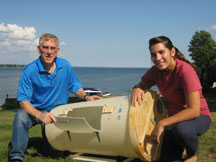By New York Sea Grant Launch Steward Ashley Regan
New York Sea Grant 2012 Launch Stewards Program
Contact: Mary Penney, NY Sea Grant, E:
mp357@cornell.edu, P:315-312-3042
It is quite amazing to see rotting plant matter decay into sweet-smelling earth. Some progressive Central New York residents are converting unwanted aquatic invasive species (AIS) into a usable product.
Composting is the process of recycling decomposed organic materials into a rich soil known as compost. Anything that was once living will decompose. By composting your organic waste you are returning nutrients back to the soil. Finished compost looks like crumbly, dark brown soil.
One specific invasive species that is readily available on Oneida Lake and other local waters for composting is European water chestnut. In his New York Sea Grant (NYSG) fact sheet on Water Chestnut (
pdf), invasive species specialist Chuck O’Neill notes that the invasive aquatic plant (
Trapa natans) was inadvertently released into the waters of the Northeastern US in the late 1800s and is slowly but unavoidably spreading throughout New York State, clogging waterways and altering aquatic habitats.
Water chestnuts can be uprooted (pulled) by hand and put into personal compost piles or bins in small quantities for decaying. This composting process is similar to recycling grass clippings.
O’Neill’s cautions regarding composting water chestnut include the fact that the fruit of this AIS is hard, sharp, and can survive a short period of composting, thus requiring a longer composting time to completely decompose, which is essential before applying. Some water chestnut seeds may remain viable for years so the composting area must be away from surface waters.
For larger volumes of organic waste, individuals or businesses may use a licensed composting facility that may accept aquatic plants as “yard scraps.” To view the composting facilities nearest you, see the
New York State Department of Environmental Conservation’s website on Composting Facilities in New York State.
Water chestnut when composted into fertilizer can add nitrogen, phosphorus, and potassium nutrients to the soil. For this reason it is most often considered a soil conditioner that improves the structure and texture of the soil, enabling it to better retain nutrients, moisture and air for the betterment of plants.
On July 11, 2012, local citizens gathered at the North Shore of Oneida Lake to learn about composting this invasive species as a part of a water chestnut pull sponsored by the Oneida Shores Rotary Club in partnership with New York Sea Grant. NYSG Launch Steward, Nick Spera and I demonstrated how to prepare unwanted aquatic plant matter for composting. Of the 450 pounds of drained water chestnuts collected, 100 pounds was added to the Rotary Club’s compost pile. The composted AIS will eventually be used as a natural (organic) fertilizer on various fruits and vegetables.
Marvin Reed, head of the Oneida Shores Rotary Club, noted that my lecture showed how holistically thinking of AIS as part of a revolving life cycle leads to creative value-added steps such as the composting of AIS.
“I was in Big Bay Creek (recently) and was alarmed at the water chestnuts. They seem to have doubled or tripled in just three weeks’ time. I also spotted many water chestnuts near Oneida Shores Park on the east side near the fishing spot. Water chestnuts and other invasive species will continue to be an issue for Oneida Lake. We will need yearly surveys and weed pulls to keep water chestnuts and other invasive species under control," Mr. Reed said.
“It was nice to have the New York Sea Grant Launch Stewards participate with the Rotary Club in addressing the local invasive species issue,” Mr. Reed added.
More information on the July Oneida Lake Water Chestnut Pull and a how-to compost AIS fact sheet are online at
www.nyseagrant.org/ccd under Workforce Development.

New York Sea Grant Launch Steward Ashley Regan and Oneida Lake Rotary Club leader Marvin Reed with a compost turner.
Photo: New York Sea Grant
This is the sixth article in a series by the New York Sea Grant Launch Stewards. The stewards are college students helping to educate water users and shoreline property owners about how they can help slow the spread of aquatic invasive species. The Launch Stewards located along Oneida Lake, the eastern shore of Lake Ontario, and at the Salmon River Reservoir are part of a statewide project. Learn more online at www.nyseagrant.org/ccd.